I’ve been carrying a Streamlight Wedge for the past couple of years as my primary EDC light. It’s a great light. It’s flat, and it has a pocket clip so it carries much like a folding knife in your pocket. It puts out a very usable 300 lumens of light for routine use and has a a 1,000 lumen “Thro” setting for shorter burst when you need to put more light onto something. It’s rechargeable, and has a 3-hour run time in normal mode. About the only negative to it in my mind is that it’s a little long at 5.5 inches overall. Some folks didn’t care for the side mounted rotating thumb switch either, although that wasn’t something I minded.
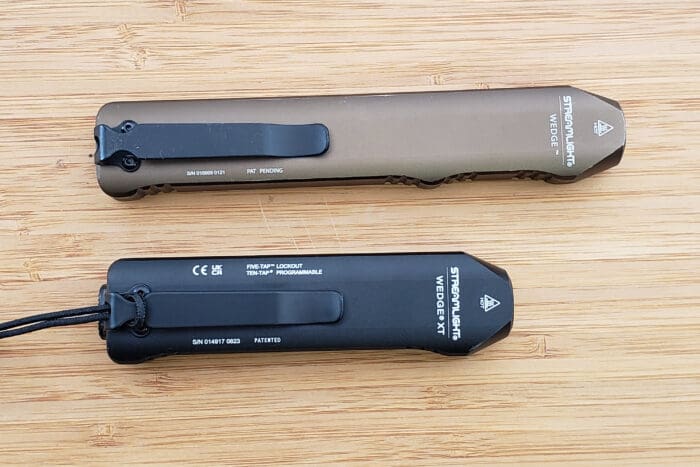
The Wedge XT
Well, Streamlight does listen to feedback and the Wedge XT is the result of that. They still make the original Wedge, but if you want something a little smaller, the XT is for you. The XT knocks a little over an inch off the overall length and comes in at only 4.25 inches. It actually ups the standard illumination by giving you 500 lumens on high for 2 hours, and a low setting with 50 lumens of illumination for an impressive 11 hours.
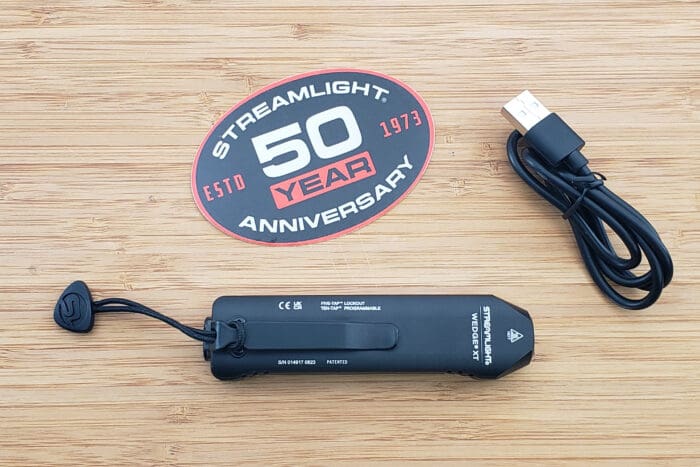
Like the Wedge the XT is rechargeable using a standard USB C cable. One is included in the package. It features an integral lithium polymer battery and will fully charge in 6 hours. A charge indicator light is located near the charging port in the side of the light. Red indicates it’s charging, and green indicates that it’s charged. A battery status indicator will also illuminate briefly when you first turn the light on. Steady green means you have sufficient power for use and steady red means that the battery needs to be charged.
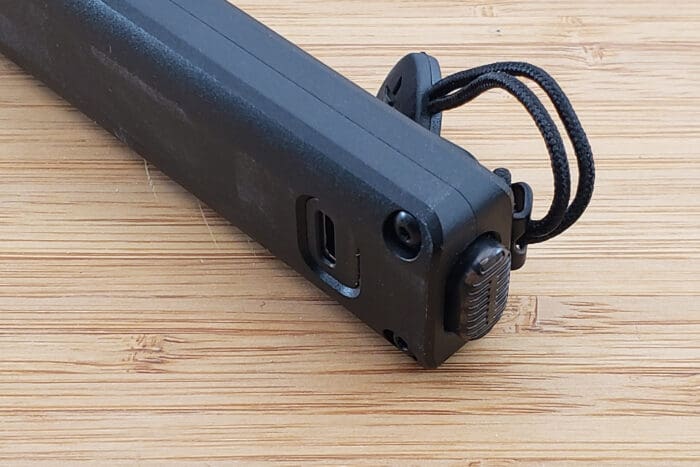
Streamlight changed from the side-mounted switch on the Wedge to a tail cap button that allows for either momentary illumination with a light tap or press, or steady on option with a solid press. Out of the box it’s set up to come on high mode and switch to low with a double tap. It has Streamlight’s TEN-TAP programmable switch, which will allow you to switch from high/low to low/high if that’s your preference. Since I like the high/low set up, I didn’t mess with it. It also has what they call the Five-Tap lockout feature, which prevents the light from coming on in your pocket.
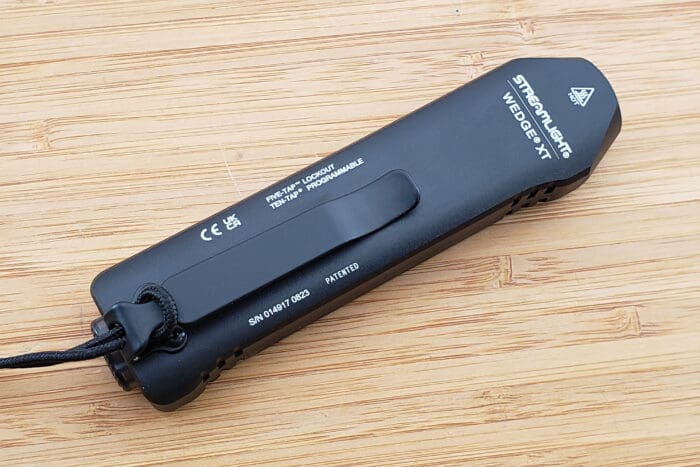
The body of the Wedge XT is made from aircraft aluminum and anodized in either black or Coyote finishes. It comes with a deep carry pocket clip, and short lanyard installed. The XT is IPX7 waterproof rated to 1 meter, and tested for 1 meter impact resistance. So it isn’t a dive light, but that should be more than sufficient for EDC use, even in foul weather.
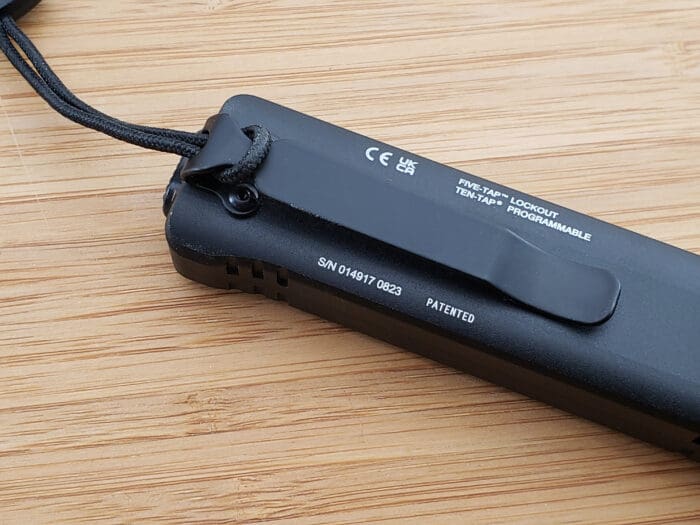
EDC Use
I swapped out my Wedge with the Wedge XT over the past couple of months. The most immediate thing I noted was the size difference. The shorter length does make a difference when it comes to pocket carry. The longer Wedge would sometimes push up in my pocket when I’d sit down, or dig in, depending on how I was sitting. Knocking that inch and a quarter off the length on the XT made all the difference, and I didn’t find that either of those things happened any more. The deep carry clip keeps the light securely fastened and discretely carried in the pocket. You can either tuck the lanyard in to the pocket, or leave it hanging out to make it easier to retrieve the light. If you don’t care for the lanyard it’s easily removable as well.
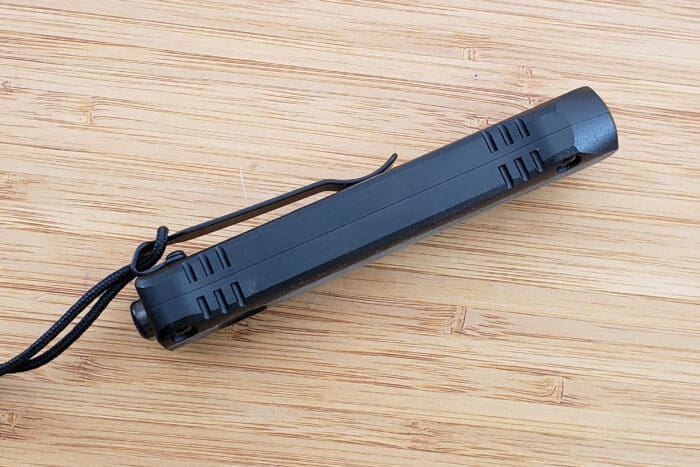
With it’s flat profile, rounded edges and slight ramp with thumb serrations near the lights bezel, the XT is comfortable to use. It’s big enough to get a decent grasp on, but small enough to carry easily. The flat profile helps in that too. It’s way less bulky in the pocket than most round flashlights of similar power level. Weight is only 2.62 ounces too so it’s hardly noticeable.
The High and Low modes seem to work well for most EDC tasks. Five hundred lumens will definitely light up a room, an alleyway or a backyard. I know a lot of folks are fixated on ultra-high lumen lights, and there are plenty of 1,000-lumen or better lights out there, but 500 works pretty well. The lower 50 lumen setting is fine for utility use like looking for something in your tent if you’re camping, or getting your house keys out and in the front door if you get home late at night.
While I had practiced with the side-mounted switch on the Wedge to use it in conjunction with a pistol, I will say the tail cap mounted momentary switch of the Wedge XT is much more natural for most flashlight shooting techniques. It’s perfect for the Harries technique and works for the FBI and Neck Index styles as well. The flat profile and lack of support ring do not lend itself to the Rogers/Surefire style however.

Wrap Up
I liked the Wedge a lot, and still have it in my carry rotation although I’ve now mostly left it in my pack and travel bag. For pocket carry, I’ve switched to the Wedge XT. I think Streamlight did a great job of taking an already innovative light and improving upon it with the changes they made for the XT. The combination of form factor, size, usability and light output make it a top choice for EDC use. The price is quite competitive as well, with actual street prices coming in under $90 at most places. If you’re in the market for an easy to carry, rechargeable EDC light, I’d definitely say give the Wedge XT a hard look.

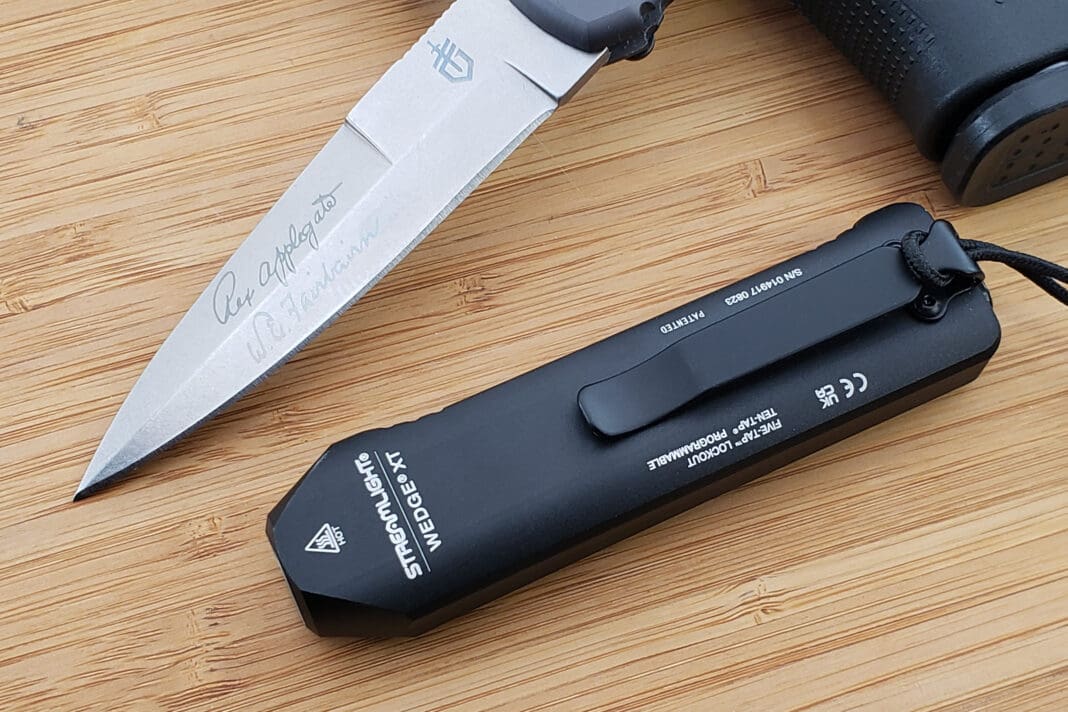





Oh please no, not another flashlight…. no no no, ARGHHHHHHHHH!
not sure if this will tailstand. even if it will, on the button, a sneeze would knock it over. it’s not going to roll away though, and the clip looks to be a good design. lumens and ratings are weird: my jet beam is a claimed 900, actual tested at 750. my (work) streamlight is rated at 350 and is noticeably brighter and throwier. 500 here will be very bright but only turbo and 50 leaves no true moonlight low, which is where i want all mine to come on (disturbs no one and satisfies 80% of my usage situations).
i’ll reiterate my fondness for infinitely variable rotaries and obtaining an lep torch.
There’s two reasons for this:
1. Lumen output is total light output over an area (simplified explanation) – you need an integrating sphere to measure this. Generally speaking, a flood light will be really high while a pencil beam, even with extreme peak intensity, will come up low.
2. There is an oversight committee for marketing specifications on flashlights that produced the ANSI FL-1 standard. If a company has the FL1 standard logos on their packaging, it has been lab tested. If not, they can claim whatever they want (and the majority will do it by mathematically calculating ideal light output, not accounting for losses).
There’s also a lot of small factors that can make a huge difference in output. For example, I experimented with the inner LED plastic surround on a ~700 lm 2xCR123 handheld I developed with a focusing optic and no dish reflector (the plastic surround was effectively the reflector). When the plastic trim panel was switched from black to white, light output increased over 70 lm in the sphere.
Well, that fixes 2 of the 3 reasons my Wedge lives in my nightstand instead of my pocket. Now, flip the clip so you can clip it to the brim of your hat for hands free. Even with the accidental activation issue I still prefer the Stiletto for now.
I see that this light is made in china. I’ll pass.
Bought one of these a while back. Owned it for less than a month and it let the magic smoke out while charging. Not a fan.
No China. You’d think that better companies would get that message.
Hard to see any advantage over the Macrostream.
Rechargeable flashlights are stupid.
they are perfect for edc, no good for hiking/ wilderness. get a rechargeable that is compatible with aaa, aa, cr123 and carry spares while away.
Cool profile/size choices for the light in some regards.
A false edge on an Applegate-Fairbairn is fucking blasphemy and someone at Gerber needs to be dragged out and shot behind the chemical sheds.
BuT iT’s dA fOlDeR KnIfEZ!!
Fuck off Gerber. Go keep the blade they way it was originally designed and make it an OTF or keep it as a fixed blade.
strych, you let the purist out again. the vast majority of spearpoint folders have only one edge.
one of the greatest bargains is the old hickory pig sticker, both edges come sharpened for around ten dollars. some guard/ quillion would be an upgrade.
that gerber looks like a mel pardue 3550 copy. sharpening the ricasso/ false edge makes it illegal in many jurisdictions, and anyhow its a pocket knife. on an ek, gerber tacll or any fairbairn sykes, for sure.
https://www.kabar.com/products/EK44
used on ebay for less:
https://www.midwayusa.com/product/1018539377?pid=124345
An Applegate-Fairbairn isn’t a spearpoint and never was. It’s a dagger’s dagger.
Don’t fuck up an iconic fighting knife where nearly every aspect of the blade design compliments the rest of the knife because, IRL, the overall package is what makes the knife what it is in both form and particularly in function. In fact, the smaller you make the blade the more you actually need that original design because that’s basic blade-craft going back 3000 years.
This is like “improving” a 1911 by giving it a Glock grip angle. It’s stupid, blasphemous and should be a capital offense.
the use of those two terms is all over the place, in legal terms it depends on country, state and municipality. look at nyc’s definition of a gravity knife. to me spearpoint is a blade design (and some say single edged) while a dagger is a knife style.
applegate made a number of changes to the original design. the first ones based on randall’s model two dagger. double or single edged it still a spearpoint, although wiki agrees with you.
https://forum.spyderco.com/viewtopic.php?t=77137
Full disclosure, yes this IS me being a bit of a purist. I not only admit this but also embrace it. I’m also going to nerd-the-fuck-out about this because it annoys me. Further, I’m not talking about the law and, for the purposes of my comment, I don’t care about the law at all.
In this case wiki probably agrees with me because someone out there actually knows what they’re talking about in terms of historical blade design. I’m actually kinda surprised, to be honest.
What makes a point a spearpoint is the way the tip is designed, as opposed to say, a needle point. It’s the angle of the edges and how they come to the tip. Some will also argue certain things about the cross section (I’m not making that argument here). In theory either one can be double or single edged depending on the desired application. The AF knife has an in-between tip. It’s not really a spearpoint (which would be slightly wider) nor is it a needle point (which would be narrower).
With regards to the knife in question: IMHO, you don’t advertise that thing as an AF knife specifically because that’s not the actual blade pattern being used. Especially if the blade style was changed after both the original designers were dead because in this case “kinda close” ain’t the deal. It was meant to be double edged. If you want to call it a AF knife, it must then be double edged. Putting their signatures on a blade they 1. didn’t create and 2. which is inferior to the blade they did design is simply a cash-grab.
A double edged knife, regardless of law, is double edged for a couple of reasons. The main reason is because of the wound channel it creates when used as a stabbing weapon (with larger weapons there are other reasons, such as avoiding a large backstroke in confined areas, which is why a naval dirks are mostly made the way they are, though some of them, like the Japanese versions, are not double edged). It slices cleanly on both sides as it penetrates, giving you double the chance to sever an artery or major vein with a nice, clean cut. Those clean cuts are less survivable than tearing an artery. Secondly, if you get wrapped up with someone, a double edged knife cuts in both directions which, if you know what you’re doing, means you can inflict damage even with a reverse slash which has no power and force them to let you go.
A faux edge on one side isn’t double edged, it’s single edged. It therefore doesn’t have the same, what I’ll refer to as “punching power” as the same basic blade sharpened on both edges because it doesn’t have the same capacity to cleanly cut arteries in a way that they fail to constrict. It has half that capacity. This means that it’s not going to incapacitate or kill as quickly without follow up thrusts in an actual fight (as opposed to you ambushing someone) which is something you exactly don’t want to have to do. It also requires a rotation of the knife in the hand, or switching hands, if you get caught in a situation where you can only bring the back of the blade up against your opponent.
The original blade designs for both the FS and the AF knives are meant for fighting as knives (as opposed to certain types of very large knife/sword where you can get the same basic utility from a single edge by plunging the blade in deeply and creating a very wide wound that cuts very far to one side) though they’re excellent ambush weapons too. As such, they’re meant to quickly and efficiently remove your adversary from the fight using a smaller blade and give you every advantage in making this happen. A single edged version of the same blade simply cannot do this as efficiently in the wide variety of circumstances presented by an actual fight.
The AF knife improves on some of the downsides of the FS knife, I’ll ignore the handle in this case. It’s primary use as a weapon is stabbing, but giving it a wider (edge to edge) blade allowed for a different bevel on the edge so it could hold an edge better to allow for pretty decent slashing with reasonable edge retention and light utility-knife function, both things where the FS knife tended to fall on its face.
The result is something that’s not a needle point but also not a spear point but rather a kinda in-between tip design that doesn’t need to be thickened [as much] cross-sectionally up front to prevent the blade from snapping if you hit bone, a bandoleer or whatever when trying to yank/thrust someone on to the knife which were problems with war-time manufactured FS knives. Yet, the widening of the blade still results in a slender cross-section so you can get in between ribs nearly the same way an FS knife does. Ultimately, you end up with a blade that is, honestly, a very good compromise fighting knife for the battlefields of the post-War period where knives are a thing but not a primary combat weapon the vast majority of the time.
[Side Note:
Though it’s arguable that the flaw in the FS knife’s blade durability (snapping about 3/4s out from the guard/hilt or at the guard/hilt ) was a metallurgical issue due to war-time demands not allowing for the right type of steel to be used in manufacture. While there wasn’t an official “spec” that I’m aware of, the original knife was designed for good steel to be used and the Pattern 2 and Pattern 3 knives, made during the war by multiple manufacturers, simply couldn’t be made with that quality of steel. Those Patterns are known to break when used as designed where Pattern 1 knives did not break with anywhere near that kind of regularity. ]
All in all, the crime here IMHO is taking an iconic blade designed for a specific purpose, altering it and then using the signatures of the guys who made the original blade to sell the new one when they didn’t design it and you actually made it worse, meaning you’re doing them a disservice.
Again, like swapping a 1911 to a Glock grip angle, ending up with a wonky connection between the grip and the guard and then slapping JM Browning’s name on the gun as if he fucked up the design. It’s sacrilege chasing a money grab.
that was awesome. i missed the fact that their names are etched on there, that’s disingenuous. it really is just a mel pardue 550 (or 3550) copy.
i’ve passed on the fairbarn books so far, but i know there were a lot of sucking chest wounds in hong kong.
$90 for a knife that you will have to throw away when the battery no longer takes a charge. Then you will have to buy a new one that will cost even more.
your knives have batteries?
“$90 for a knife that you will have to throw away when the battery no longer takes a charge.”
You beat me to it.
I have *zero* interest in spending nearly a C-note on something I’ll be throwing out in maybe 5 years, if I’m lucky.
C’ mon, companies, address this issue, willyas?
I bought a bunch of chineseum metal flashlights at $20 for 3 at the dollar store.Since I can get 8 packs of AAA alkaline batteries for 3bucks I’m good. For quite awhile. They have several beams. @tacticool old guy🙄😀Good enuf for my needs!
Both my EDC flashlights are well over 5 years old and still have probably 70% of their original battery life. Enough to get through a workday easily. Where before I was going thru CR123s by the box. Even with rechargeables you’ll spend less in the long run with a Stiletto or similar.
I just wish they would make pants with pockets big enough to hold my kerosene lantern.
Whut? Possums have pants????🤓
$90? My USB rechargeable was $9.99 AND it has a red dot for tormenting the cats.
I’ve got a rechargeable light on my phone. Plus I’m not afraid of the dark, I really don’t need a light at all.
Comments are closed.